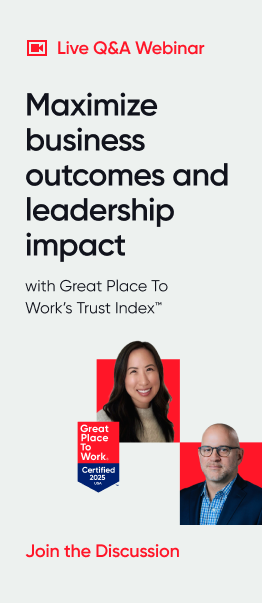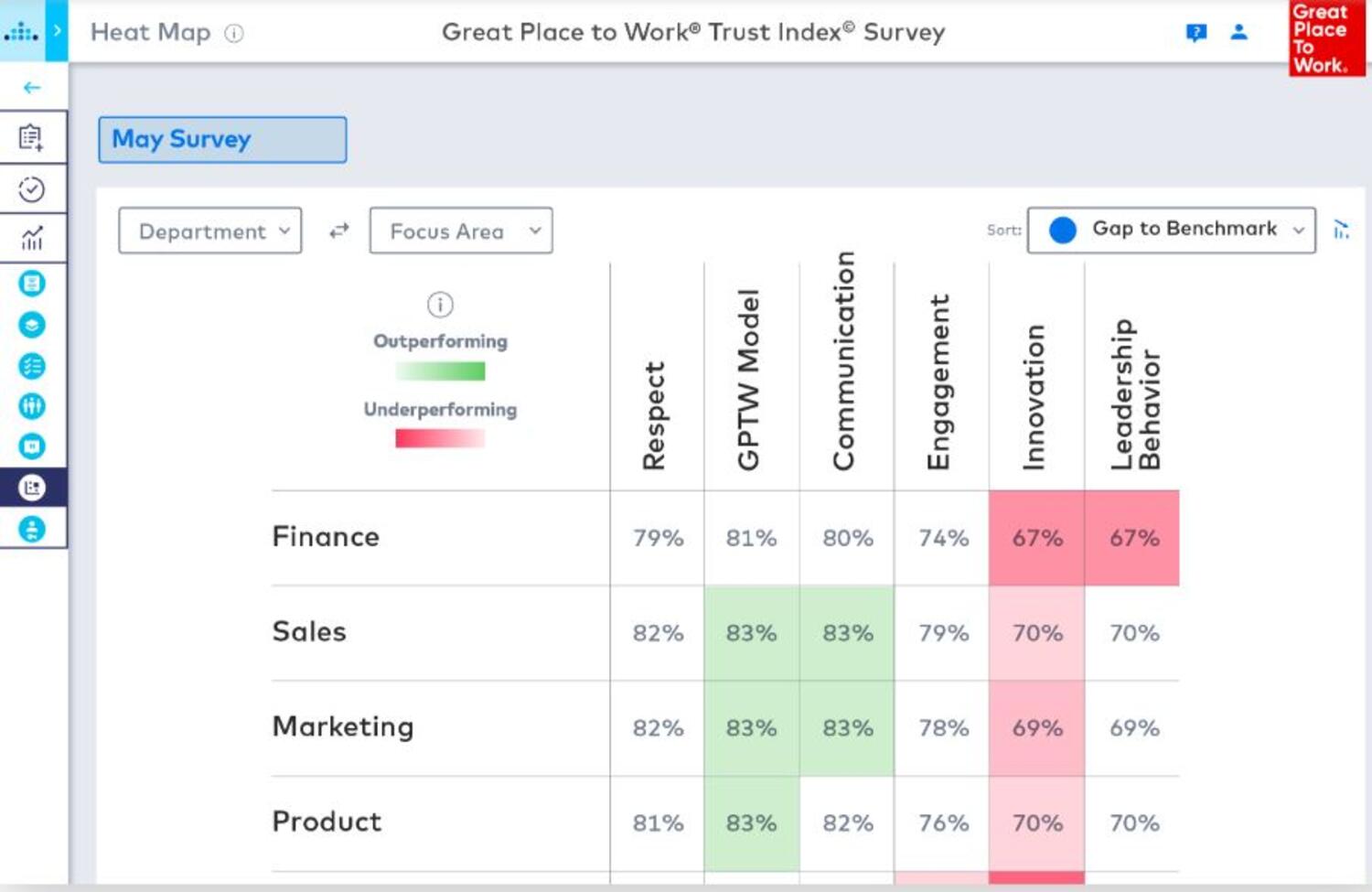Understand the essential role of effective employee surveys in fostering a positive company culture and driving improved business outcomes. By fine-tuning your employee surveys to capture crucial insights, you stand a much greater chance of making a positive influence on your organization.
When you think about employee surveys, one of the questions that probably comes to mind is, “Are these surveys even effective?”
It’s a valid question. After all, the market for talent is more competitive than ever, and as organizations look for a leg up, many have started running employee surveys — but there’s a big difference between “everyone’s doing it” and “everyone’s seeing a huge impact from it.”
Employee surveys can play a huge role in shaping a positive company culture, attracting and retaining talent, and driving better business outcomes. But these things don’t happen by chance. If you want to get the most from employee surveys, you need to understand what they do, why they matter, and how to amplify their impact.
In fact, the end of the survey is simply just the beginning of creating an effective survey cycle. In this article, we will explore the effectiveness of employee surveys, emphasizing the importance of sharing survey results, taking proactive steps to improve the workplace, and finally communicating those changes effectively to your employees.
- What are employee surveys?
- Why are employee surveys important?
- Are employee surveys effective?
- Why is feedback important in the workplace?
- Effective employee surveys and business outcomes
- Key insights in effective employee surveys
- How to enhance employee engagement survey effectiveness
- Should you survey your employees?
What are employee surveys?
Employee surveys are structured questionnaires designed to gather feedback and insights from employees about their workplace experiences. These surveys typically cover a wide range of topics, including job satisfaction, communication, leadership, work–life balance, and opportunities for growth.
Here at Great Place To Work®, for 30 years and running, our research methodology — founded on thousands of hours of interviews and focus groups — reveals that trust is at the heart of a great workplace experience.
This methodology is reaffirmed by more than millions of employees, across 98 countries and over 10,000 organizations, every year.
By collecting confidential feedback, organizations can gain valuable insights into the strengths and opportunities of their workplace culture that could be the keys to creating a “high-trust” work environment.
Why are employee surveys important?
Employee surveys play a crucial role in fostering employee engagement, improving retention rates, and boosting overall organizational performance. Surveys (especially confidential ones) provide a psychologically safe place for employees to express their opinions, concerns, and ideas in their own voice from where they are seated in the business.
This empowers employees and makes them feel valued, leading to increased job satisfaction and giving extra effort to see the company succeed. Employee surveys highlight areas and key demographic groups where the organization can make changes that will have the most impact. These focus areas often include things like switching communication styles and channels, addressing a lack of purpose at work, or promoting a more inclusive environment.
By actively seeking feedback, organizations demonstrate their commitment to creating a positive work environment. Gathering feedback via employee surveys and analyzing results positions employers to better support their people, and can even help predict and prevent employee turnover.
Are employee surveys effective?
Due to an overwhelming number of surveys administered with no meaningful change, the answer to this question isn’t the definitive “Yes!” it should be. Employee surveys are only as effective as the actions that take place as a result of the feedback; many organizations simply don’t follow through after running their surveys.
Too many surveys that don’t lead to positive changes for employees can also be negatively effective by causing skepticism and survey fatigue. To avoid survey fatigue, it’s critical to act on the feedback your surveys produce.
Great Place To Work President Paul Walcott recommends that organizations create links between surveys and the changes they inspire them to make: “What’s important is not whether you think you’re acting on this feedback, but whether your people think so. Ensure they know how new programs and procedures relate back to feedback that was provided.”
Employee surveys are only as effective as the actions that take place as a result of the feedback
Don’t assume that your people will automatically connect positive changes with the survey feedback they provided — especially if those changes take a while to roll out.
To maximize the impact of your employee surveys, your organization needs to proactively highlight the link between survey feedback and meaningful change. Leaders should recap every major improvement that has happened as a result of the last major survey.
Think of the company leader using survey results as a ship’s navigator using the stars (survey results) to guide the crew (employees) on their journey. The navigator uses each star (piece of feedback) to adjust the ship’s course (company direction); unlike on a sailing ship, the company leader can help their crew understand how the observations have shaped their journey.
Why is feedback important in the workplace?
Feedback, whether positive or negative, is a vital component of a healthy and productive high-trust workplace. When employees have a safe space to give feedback, they tend to improve their performance and contribute more effectively to the organization.
Regular feedback promotes open communication channels, fostering collaboration and teamwork. It builds trust and strengthens relationships between employees and managers.
Surveying your employees keeps your ear to the ground and helps you make both employees and customers happy.
Effective employee surveys are connected to better business outcomes
Organizations that prioritize employee listening, measure employee experience through employee surveys, and act upon the insights, achieve significant business benefits:
- Increased productivity and engagement: Engaged employees are more committed, productive, and willing to go the extra mile. Surveys help identify drivers of engagement, enabling organizations to take targeted actions to boost employee engagement levels.
- Improved retention and recruitment: A positive workplace culture, driven by feedback-based improvements, enhances employee retention and attracts top talent. Employees are more likely to stay with an organization that values their opinions and takes action to create a great work environment.
During layoffs, one of the most difficult times that an organization can go through, most companies shy away from employee surveys. But top workplaces prioritize this type of feedback — it helps them take stock of how the remaining employees are feeling after a layoff.
They use surveys to learn more about employees’ concerns, which helps them retain the employees they chose not to lay off. On the flip side, an organization in a hiring period can use employee surveys to identify organizational strengths that would appeal to potential job applicants. - Enhanced customer satisfaction: Satisfied and engaged employees are more likely to deliver exceptional customer experiences. By improving employee satisfaction through surveys, organizations indirectly impact customer satisfaction and loyalty. Delta Air Lines is a company that delivers best-in-class service by putting their own employees’ care and well-being first.
This comes through in the way Delta employees interact with customers — according to data collected by Great Place To Work, 87% of Delta Air Lines employees describe their customer service as excellent — and in the many awards the company has earned, including being named best airline by The Points Guy for the 5th year in a row.
Surveying your employees keeps your ear to the ground and helps you make both employees and customers happy.
An effective employee survey should provide several insights
To achieve maximum effect, your surveys should help you:
- Understand your organization’s drivers of engagement: Identify the key factors that impact employee engagement and tailor initiatives accordingly.
- Understand how your employee experience compares to other organizations: Great Place To Work has one of the largest datasets of employee experience benchmarks by industry and company size.
Benchmarking survey results against industry peers enables your organization to gain valuable insights into your performance and identify areas for improvement.
Each year, these benchmarks update based on the most recent Best Workplaces™ Lists — so you can see how your employee experience compares to top workplaces, including where you might be stronger or have areas of opportunity.
Analyze employee survey results at a granular level to identify strengths as well as gaps across teams, generations and other demographics. - Identify group-level differences inside your organization: Analyze survey results at a granular level to identify variations in experiences across different teams, departments, or demographics. This enables targeted interventions to address specific needs.
- Review comments to gather context: Employee comments offer qualitative insights that provide color and context to quantitative survey data. Analyzing comments can uncover underlying issues and provide additional detail for decision-making.
- Track your progress and assess changes: Regular employee surveys are central to an ongoing listening strategy. Regular pulse surveys or feedback mechanisms allow organizations to measure progress toward their company culture goals, evaluate the impact of any actions taken since the previous survey(s), and make timely adjustments.
- Identify employee personal and professional growth targets: Surveys can provide insights into individual employees’ development needs and aspirations. This allows organizations to offer targeted growth opportunities and support employees’ career progression.
7 ways to enhance employee engagement surveys
Here are a few keys to ensuring an effective survey cycle:
- Clear objectives and questions: Define clear survey objectives and design questions that are specific, relevant, and easy to understand. Keep the survey intentional and include only content that is proven to be useful and actionable data to encourage higher participation rates.
Many organizations who struggle to build their own surveys turn to Great Place To Work’s Trust Index™ Survey to have the most complete set of survey data, with ease of setup, since it’s based entirely on organizational research with built-in analysis features. - Survey confidentiality: Assure employees of the confidentiality of their responses. This encourages honest and open feedback, enabling organizations to gain more accurate insights. Using a third-party platform that is recognizable and committed to ensuring confidentiality can reassure employees of their anonymity and impartiality in data handling, fostering greater trust and encouraging candid feedback.
- Benchmarking: Compare survey results internally and externally to identify trends and areas for improvement. Benchmarking provides valuable context and helps set realistic goals.
- Empowering leaders with data: Put the results in the hands of your managers. Great Place To Work’s Manager Access feature allows people leaders to see feedback from their team and about their management style. This gives managers a sense of ownership in driving cultural change within their teams and only within their teams.
- Action planning: Ensure a structured approach to analyze survey results and develop action plans based on the findings. Involve employees in the decision-making process and communicate the actions taken in response to their feedback.
- Communicating the connection between survey feedback and positive changes: Most organizations do good by their employees by reviewing feedback from surveys and making positive changes to programs and initiatives that support their people. However, they often fail to communicate that changes were made because employees spoke up on the survey (and that employees should expect this to continue as they participate year after year).
- Targeted follow-up surveys: Conduct targeted follow-up surveys to track progress and measure the impact of actions taken based on previous survey feedback, engaging smaller subsets of employees where there are more red flags than other groups.
This demonstrates the organization’s commitment to continuous improvement, reinforces employee trust where it’s needed the most, and delivers insights you can take action on well ahead of your companywide survey.
Should you survey your employees?
Employee surveys are a valuable investment for organizations looking to understand and improve their workplace culture. Employee survey cycles, when executed effectively, serve as a powerful tool for organizations to gather feedback, enhance the employee experience, and drive better business outcomes.
By sharing survey results transparently, taking action on feedback, tapping features like Manager Access, and communicating changes made based on previous employee surveys, organizations can build a culture of continuous improvement and create a thriving workplace that attracts and retains top talent.
Embracing employee surveys as a strategic investment in your people paves the way for organizations to earn Great Place To Work Certified™ and reap the rewards of a positive company culture.
Let’s create your success story together
Powered by our proprietary platform and methodology, Great Place To Work offers comprehensive employee experience solutions that deliver actionable insights, proven to foster positive change in organizations.
Through the lens of our Trust Index Survey, we provide employee experience benchmarking, a respected workplace Certification, and Best Workplaces lists, all backed by extensive resources and a vibrant community. Learn more about the Great Place To Work Trust Index employee survey and how we can help you create a thriving workplace today.










